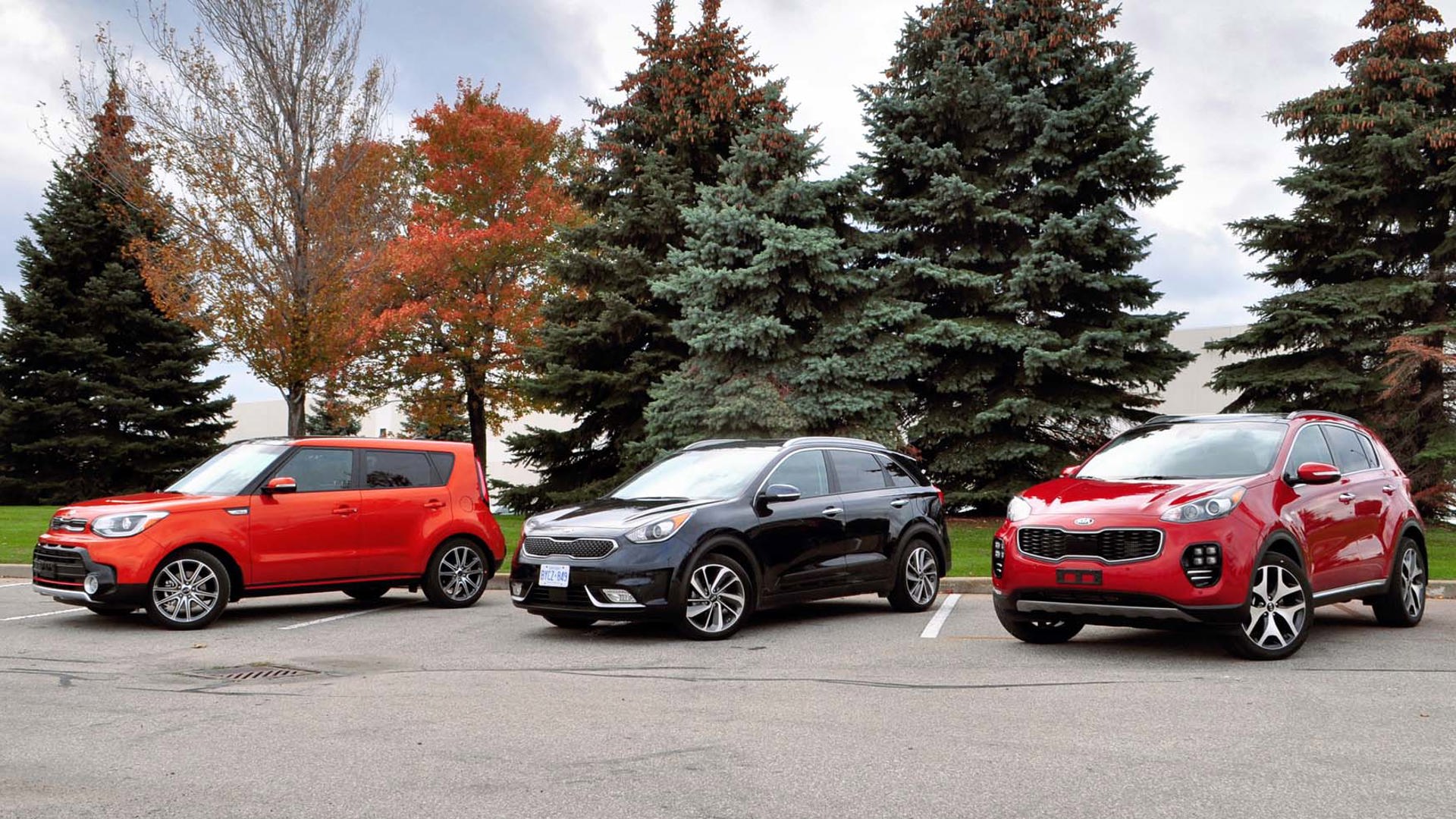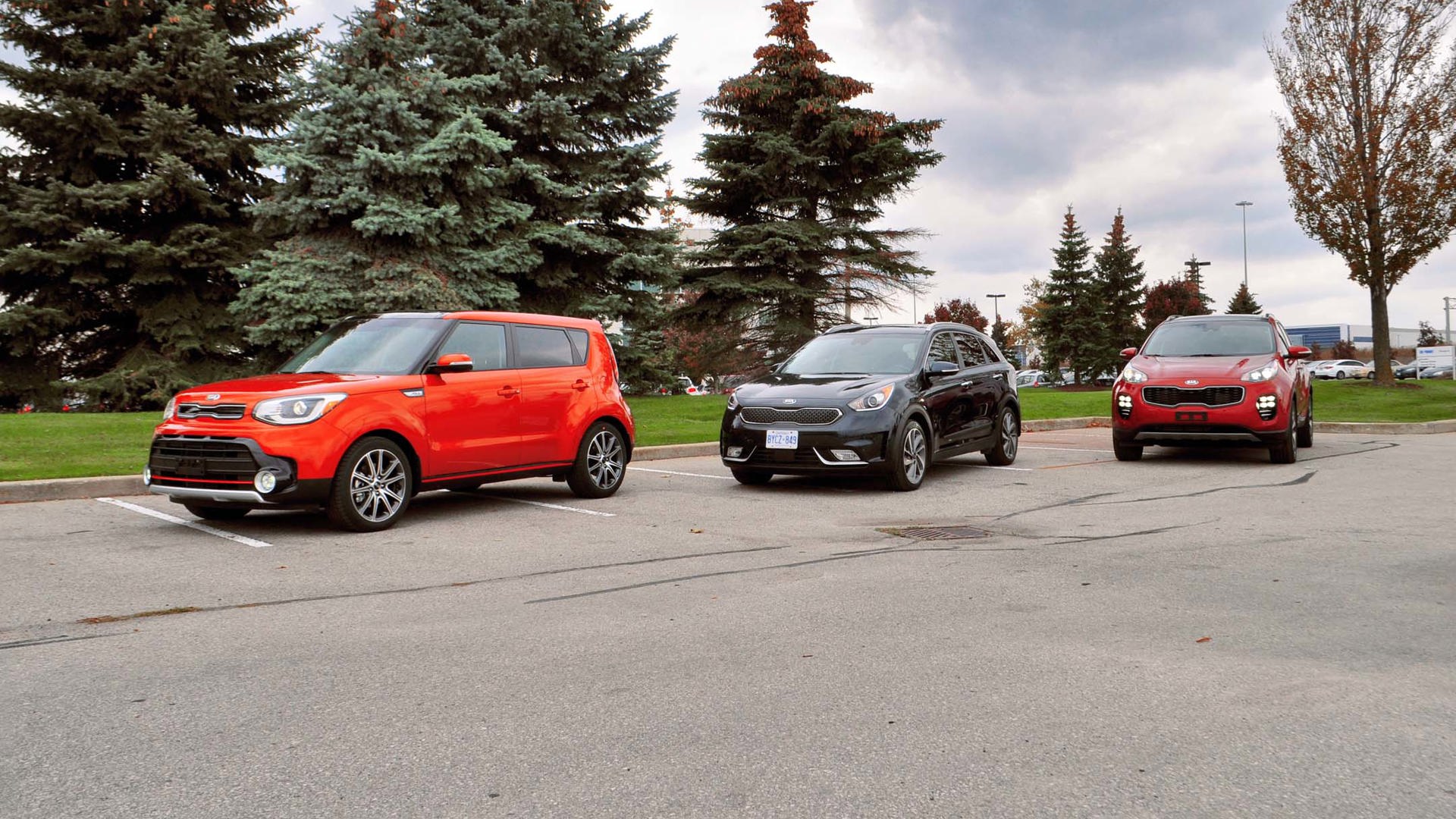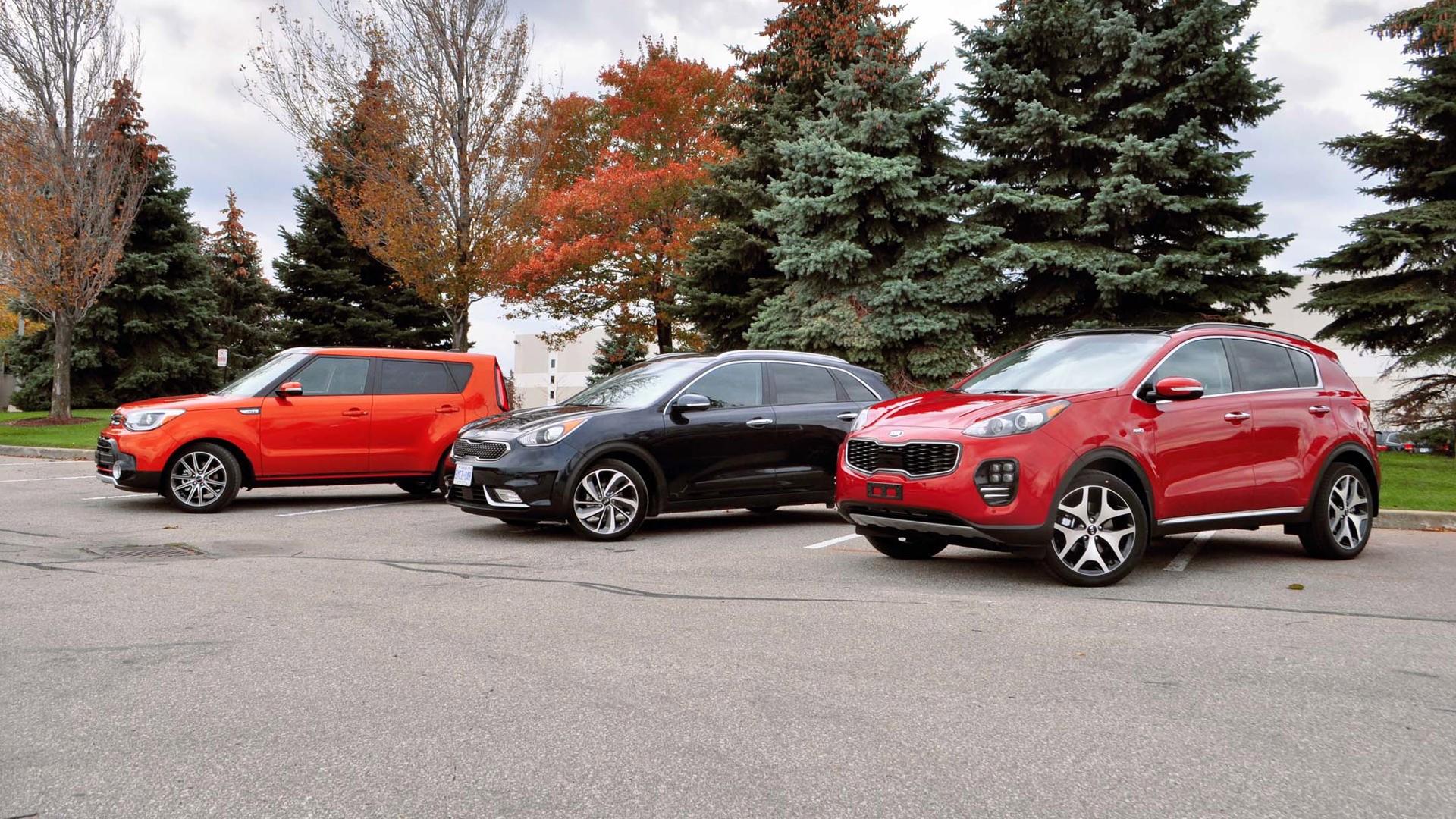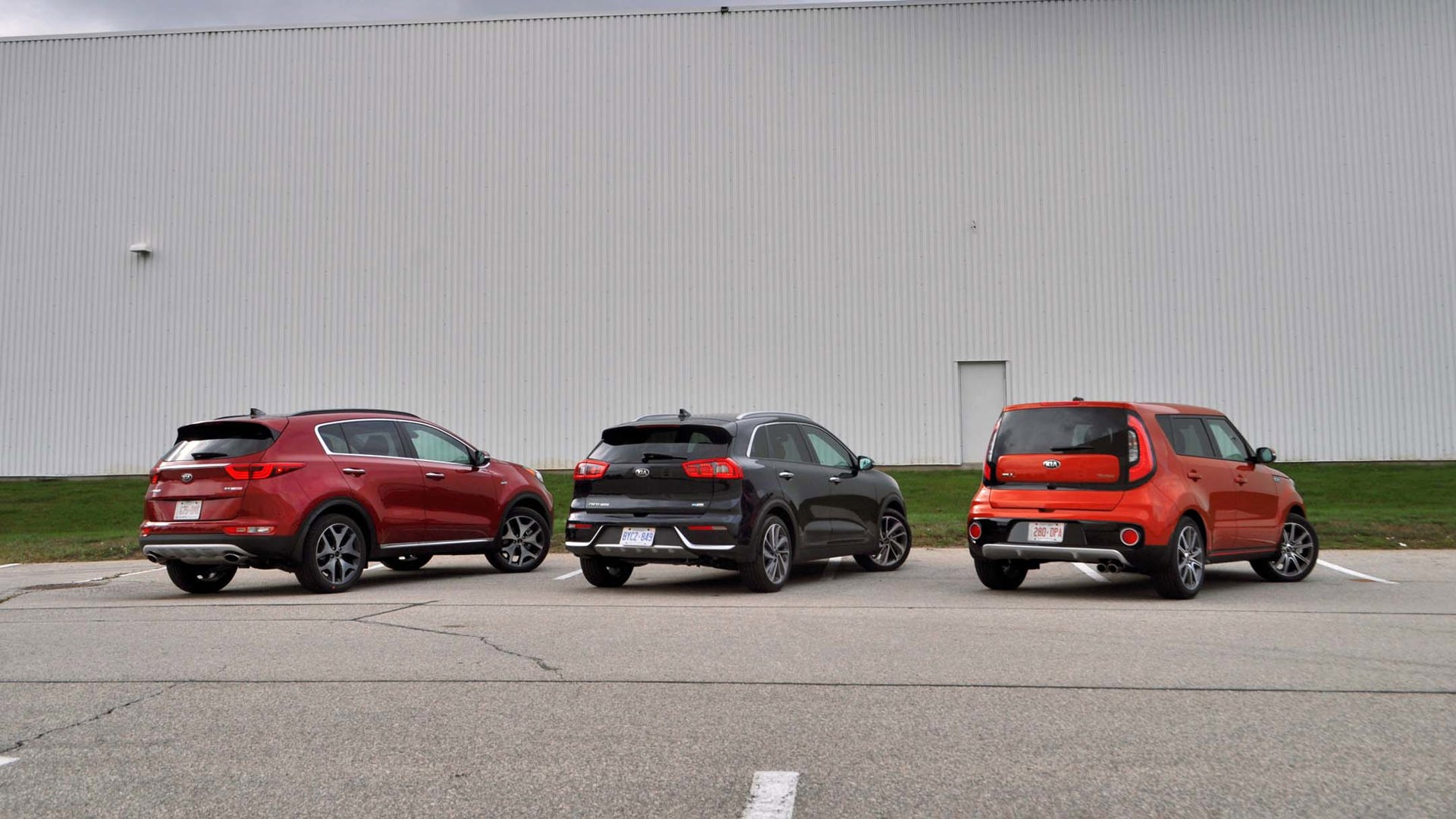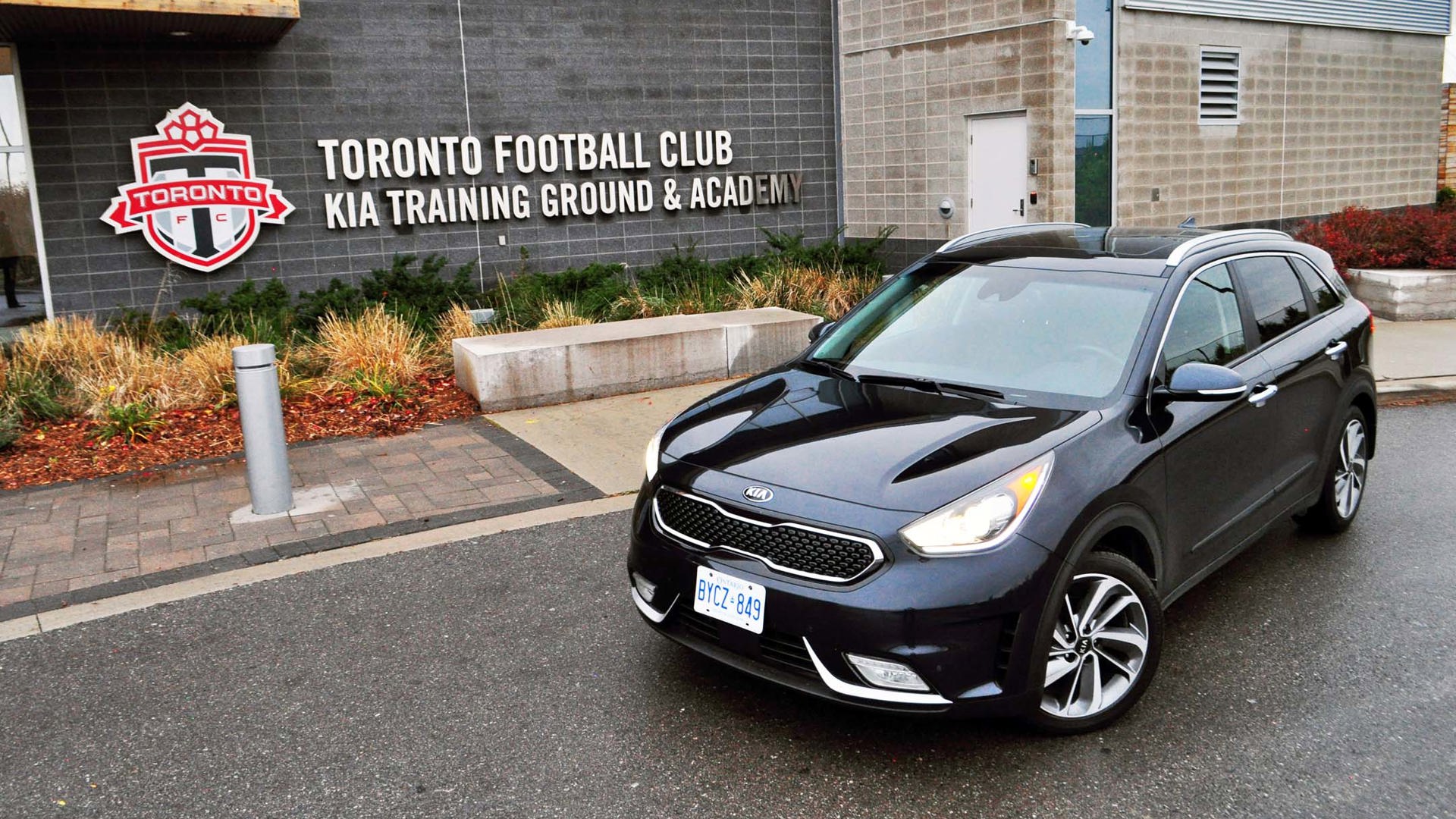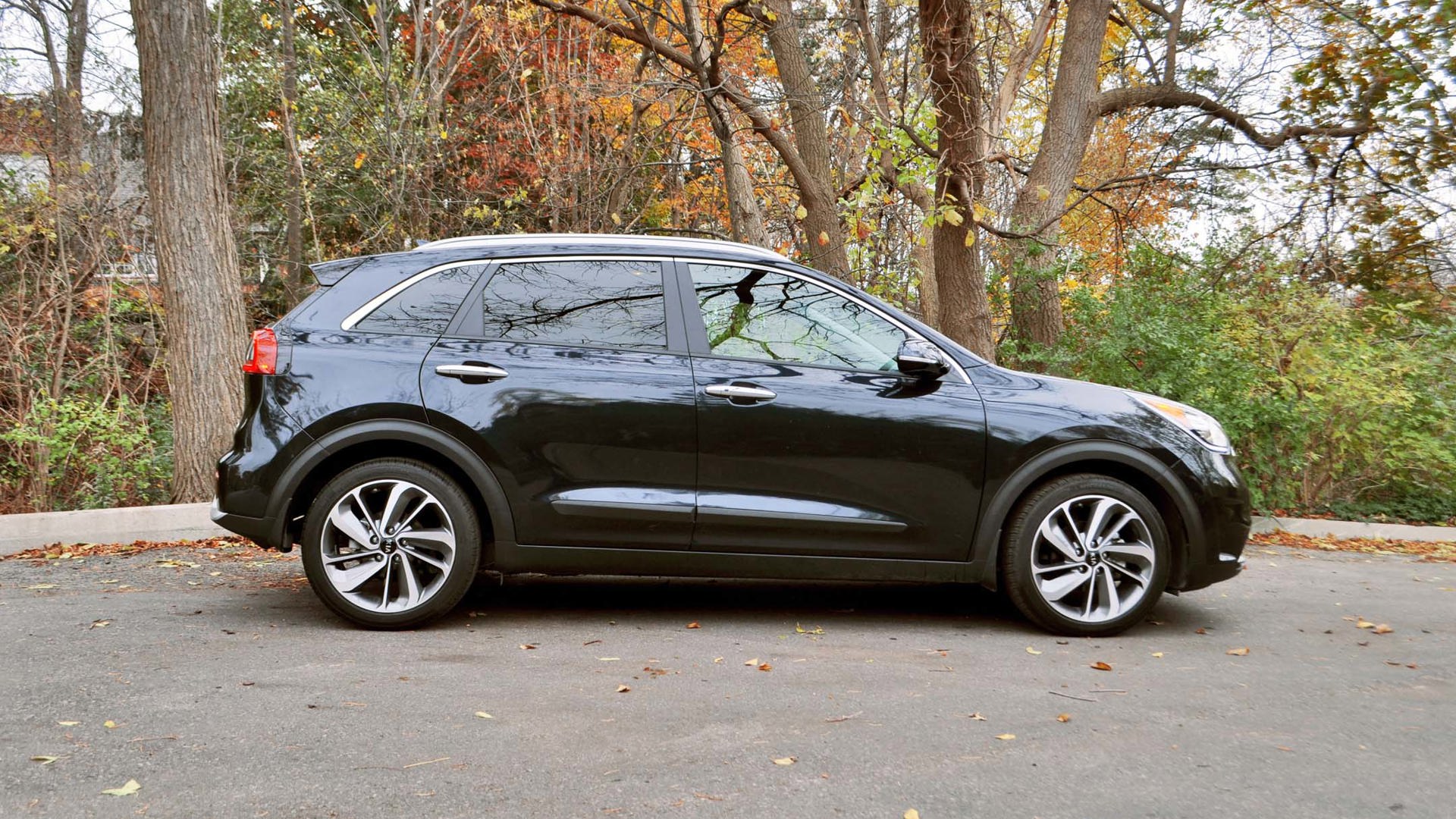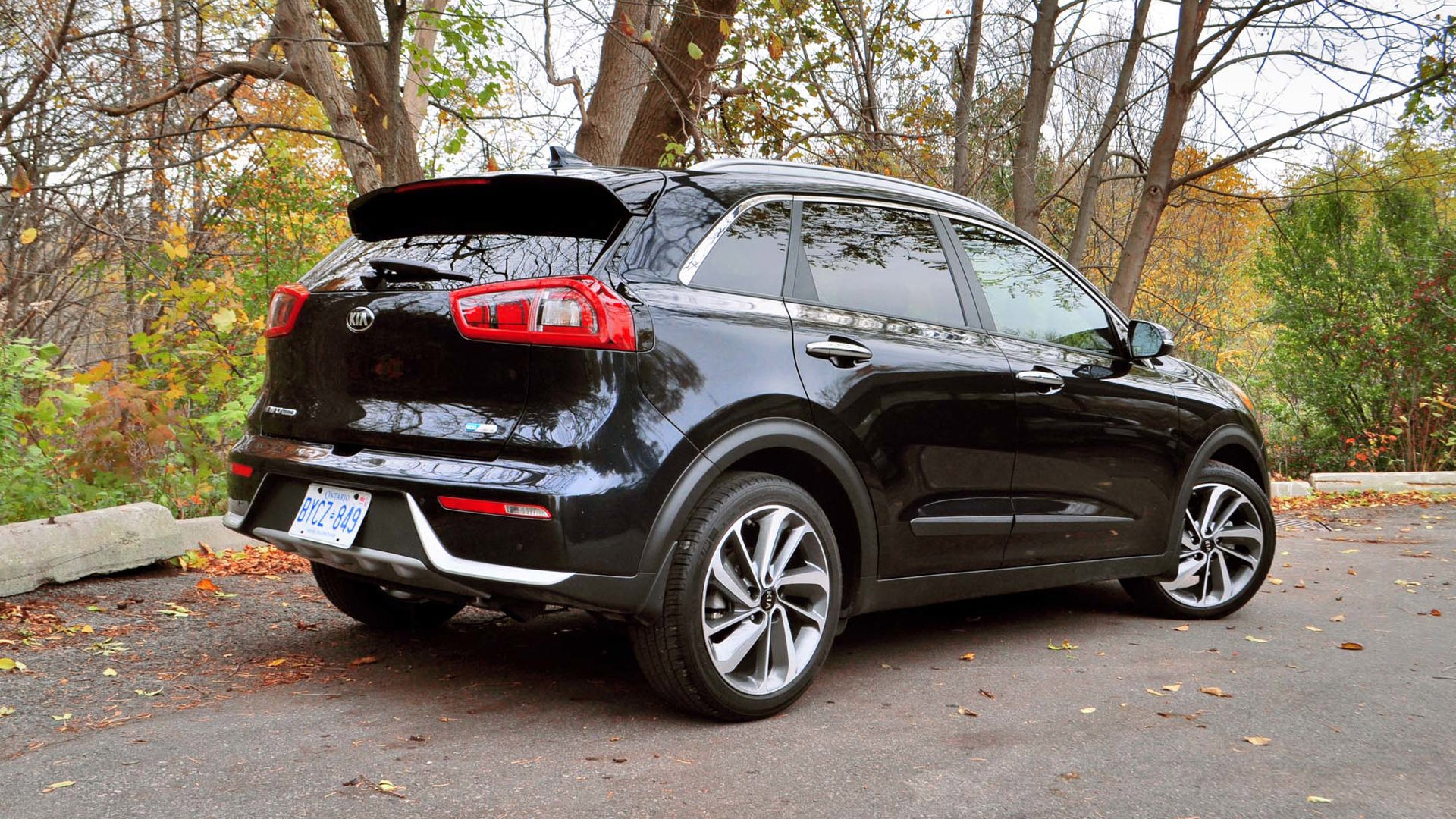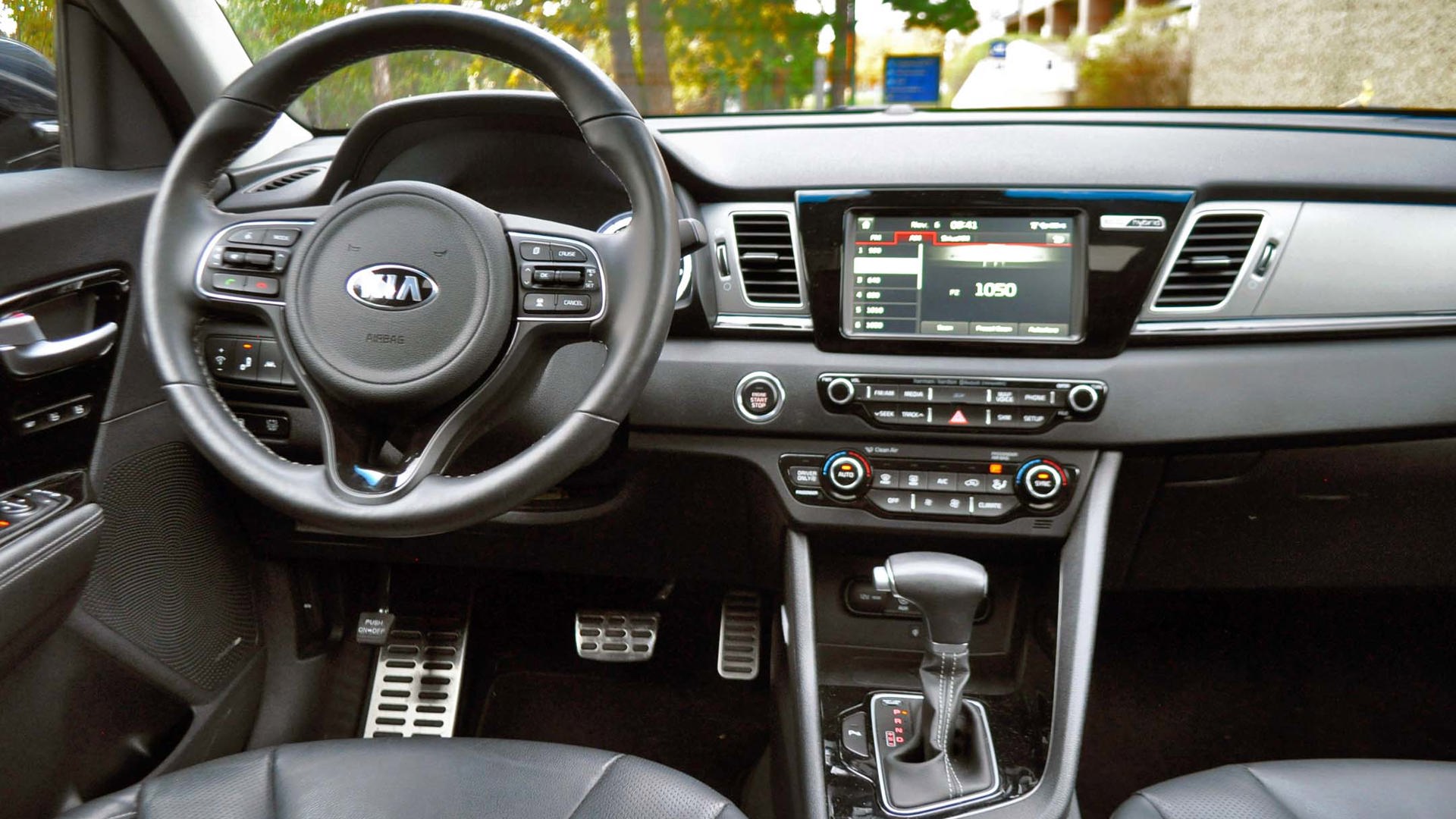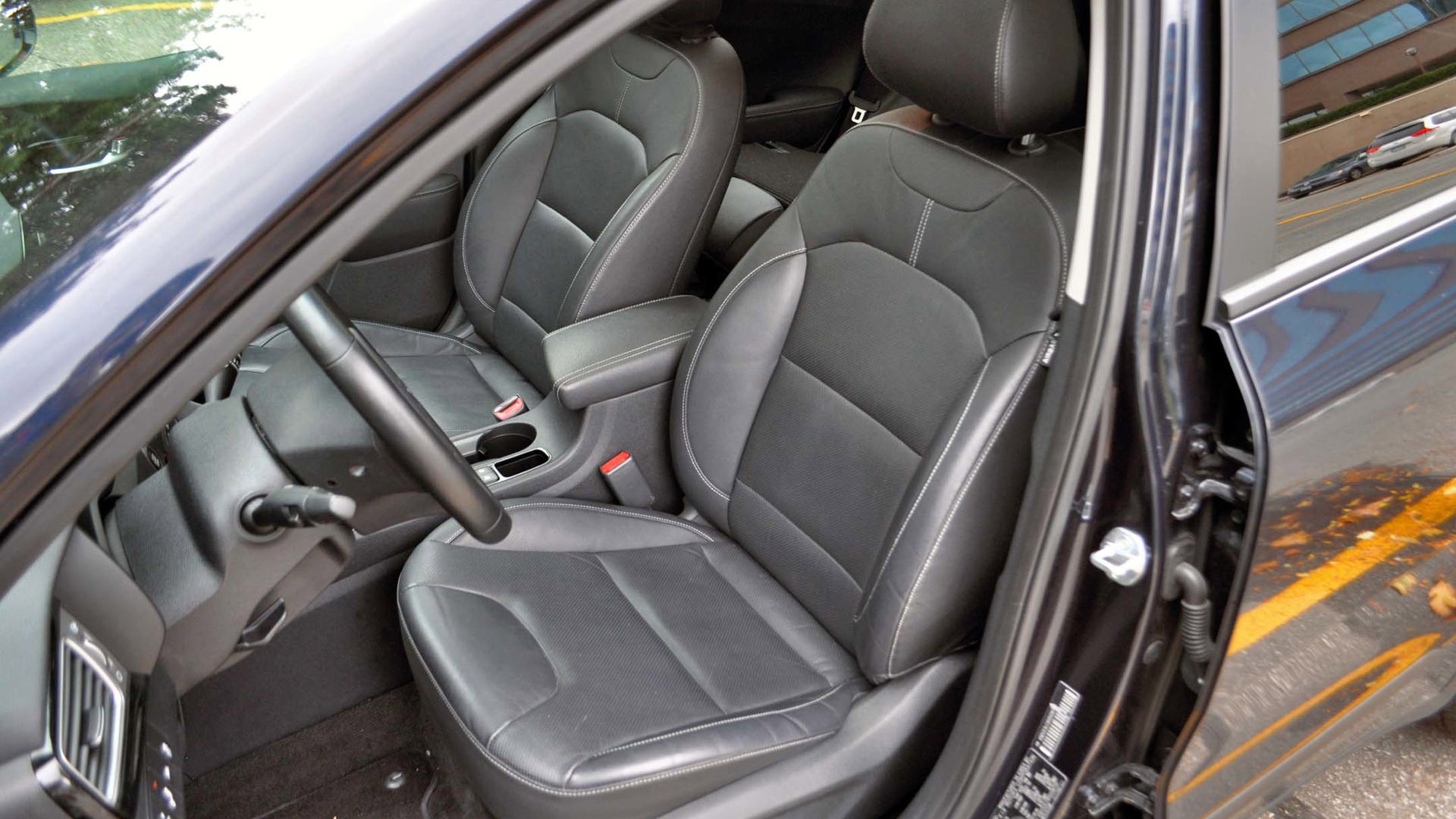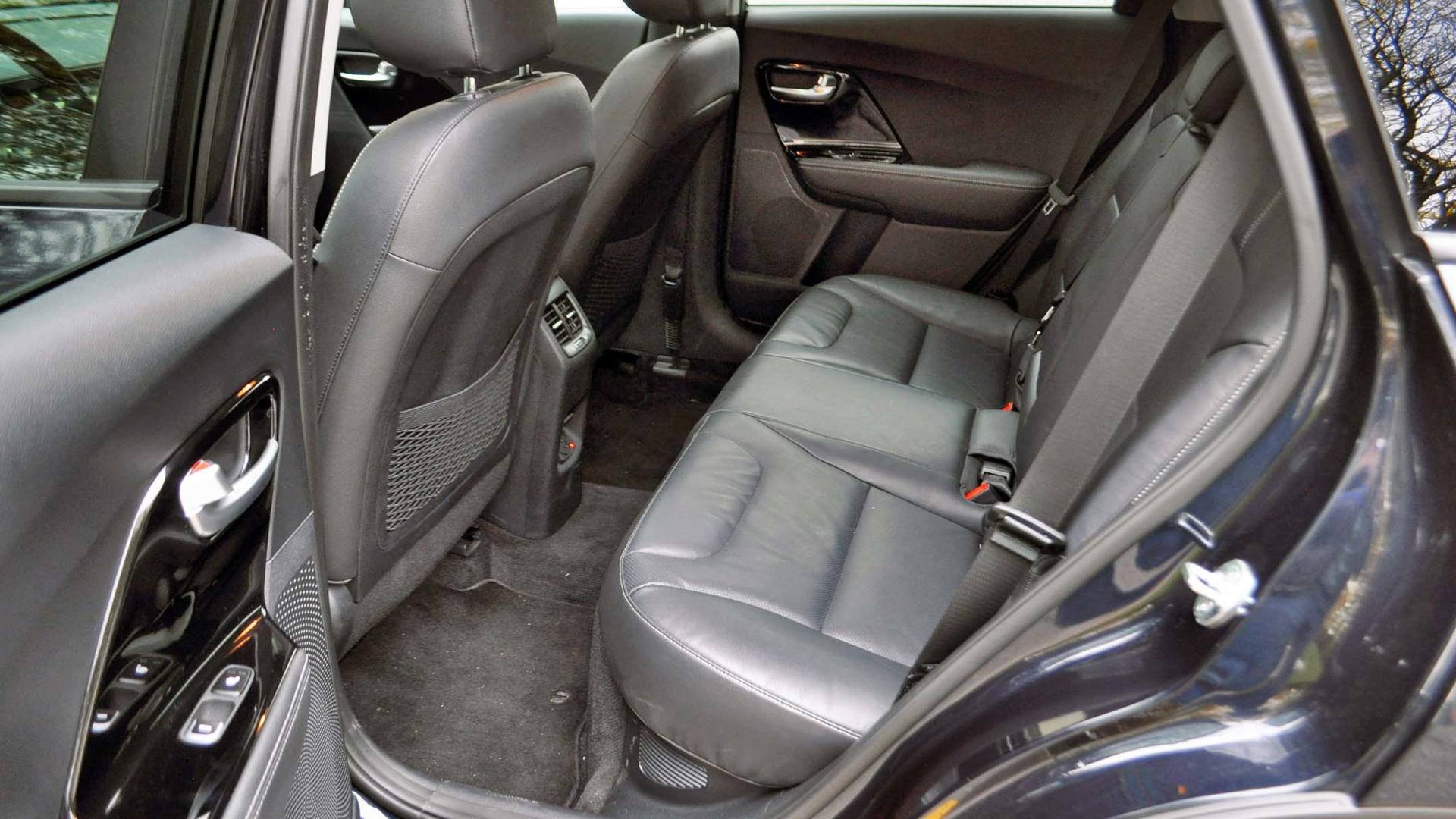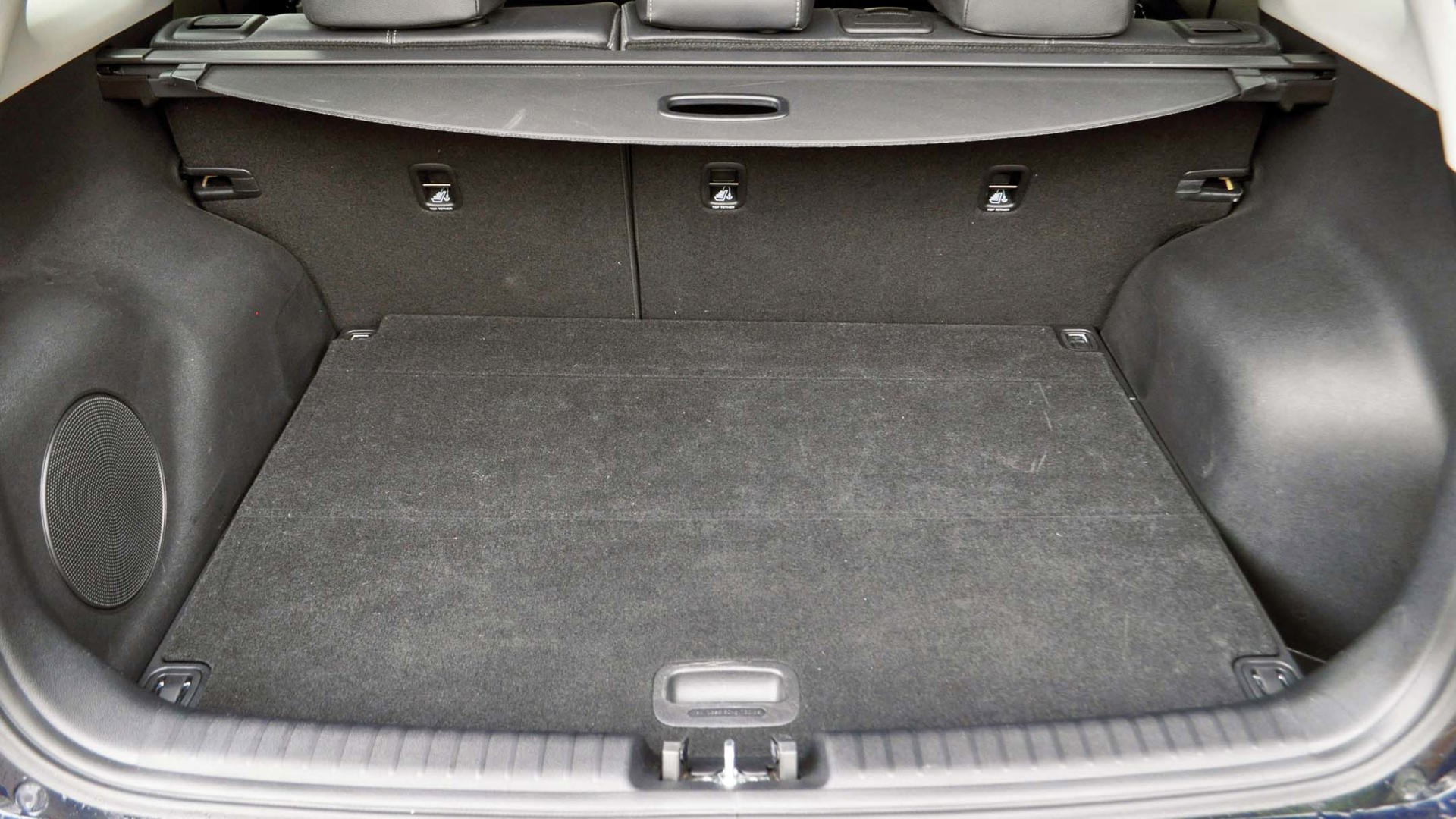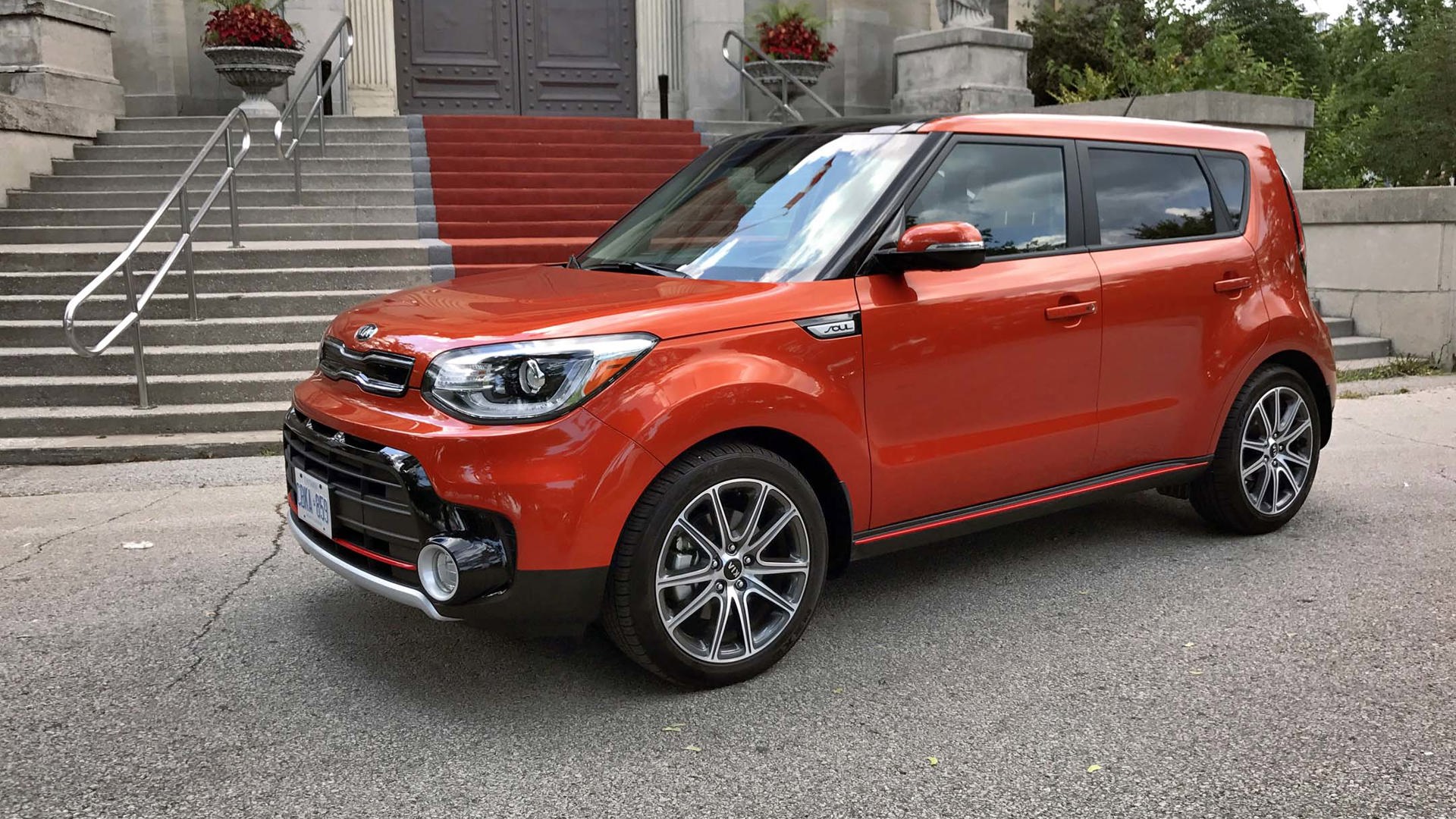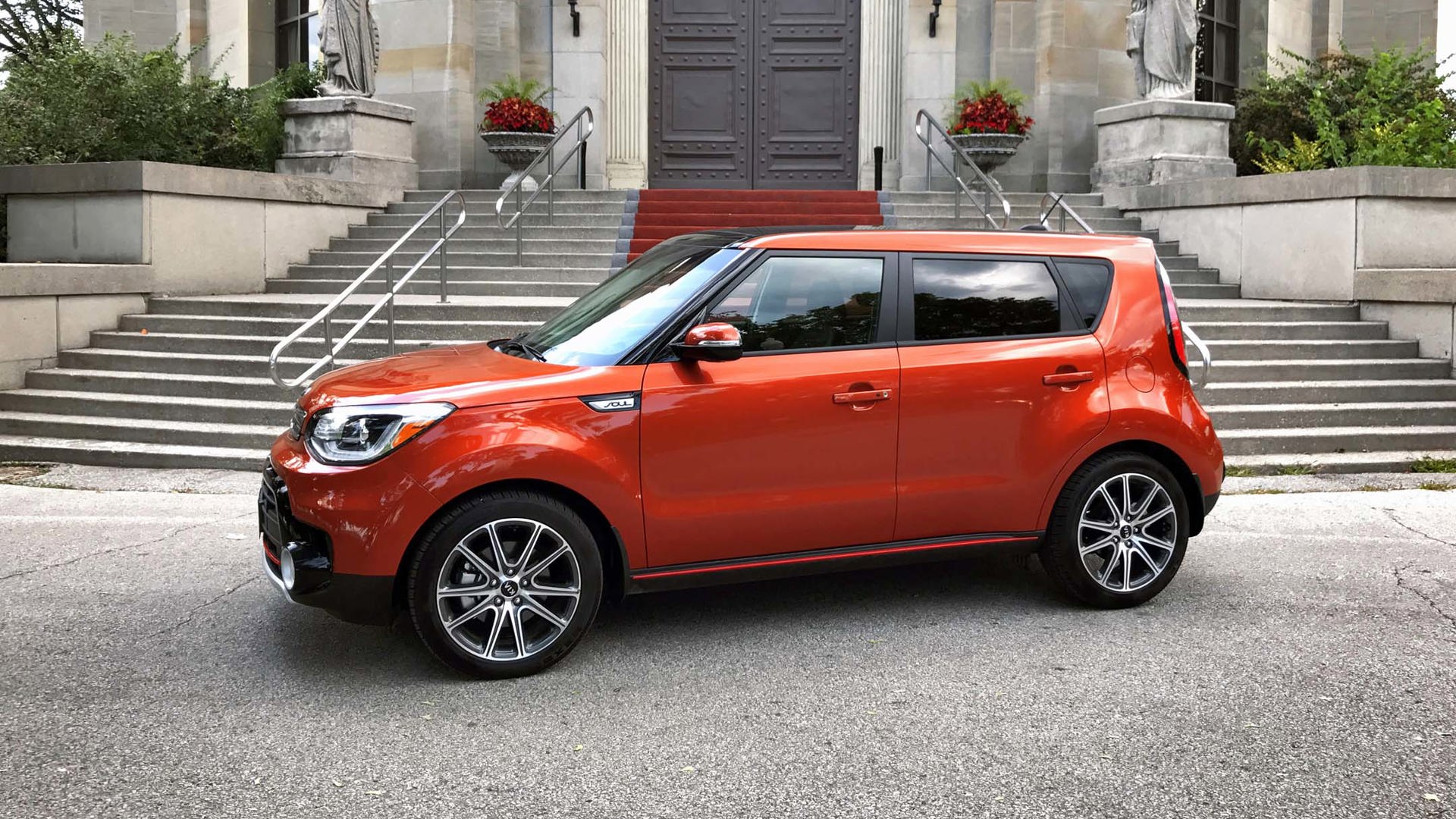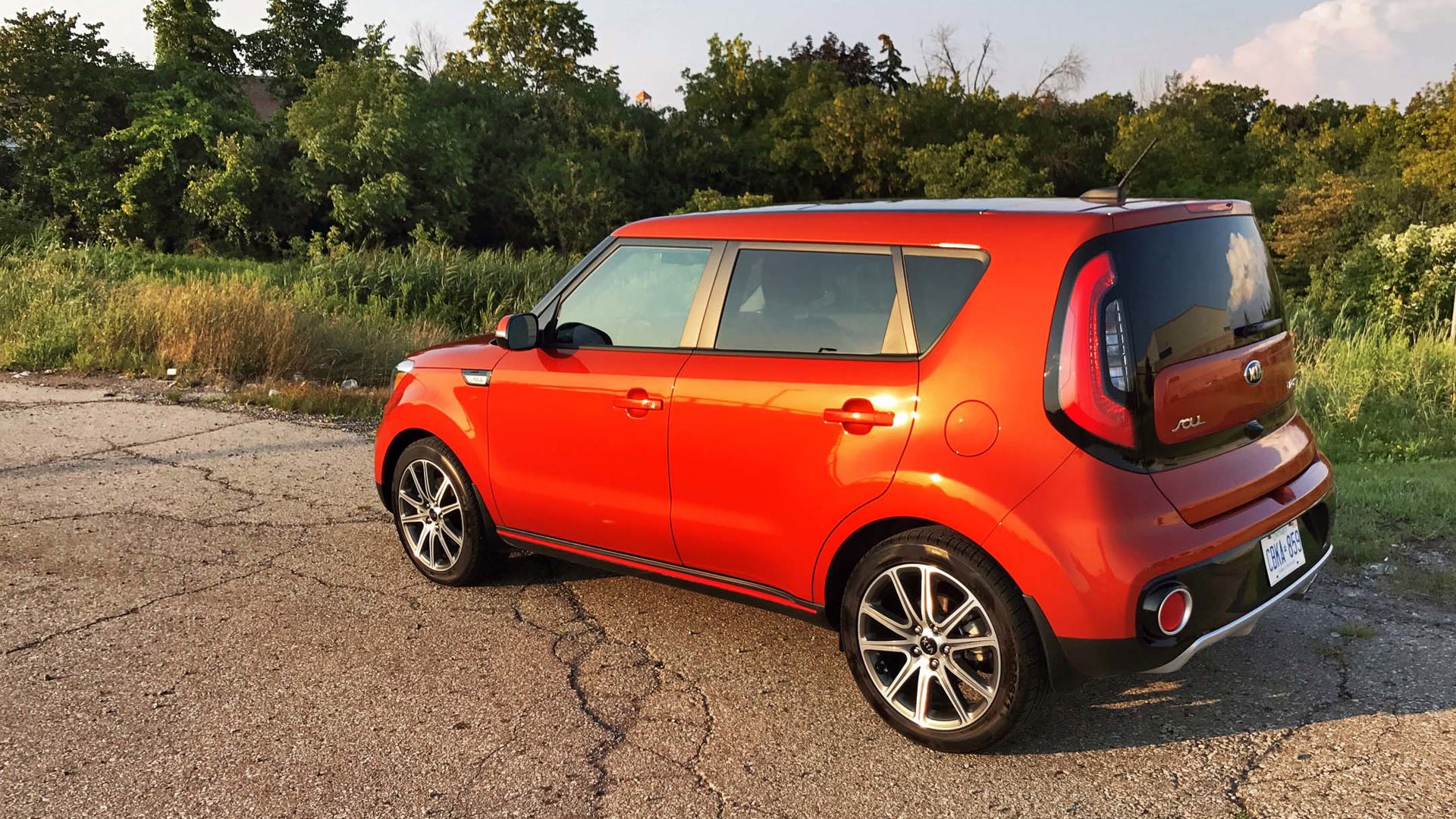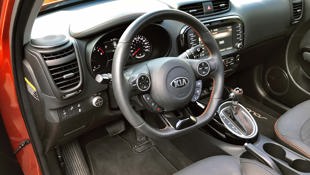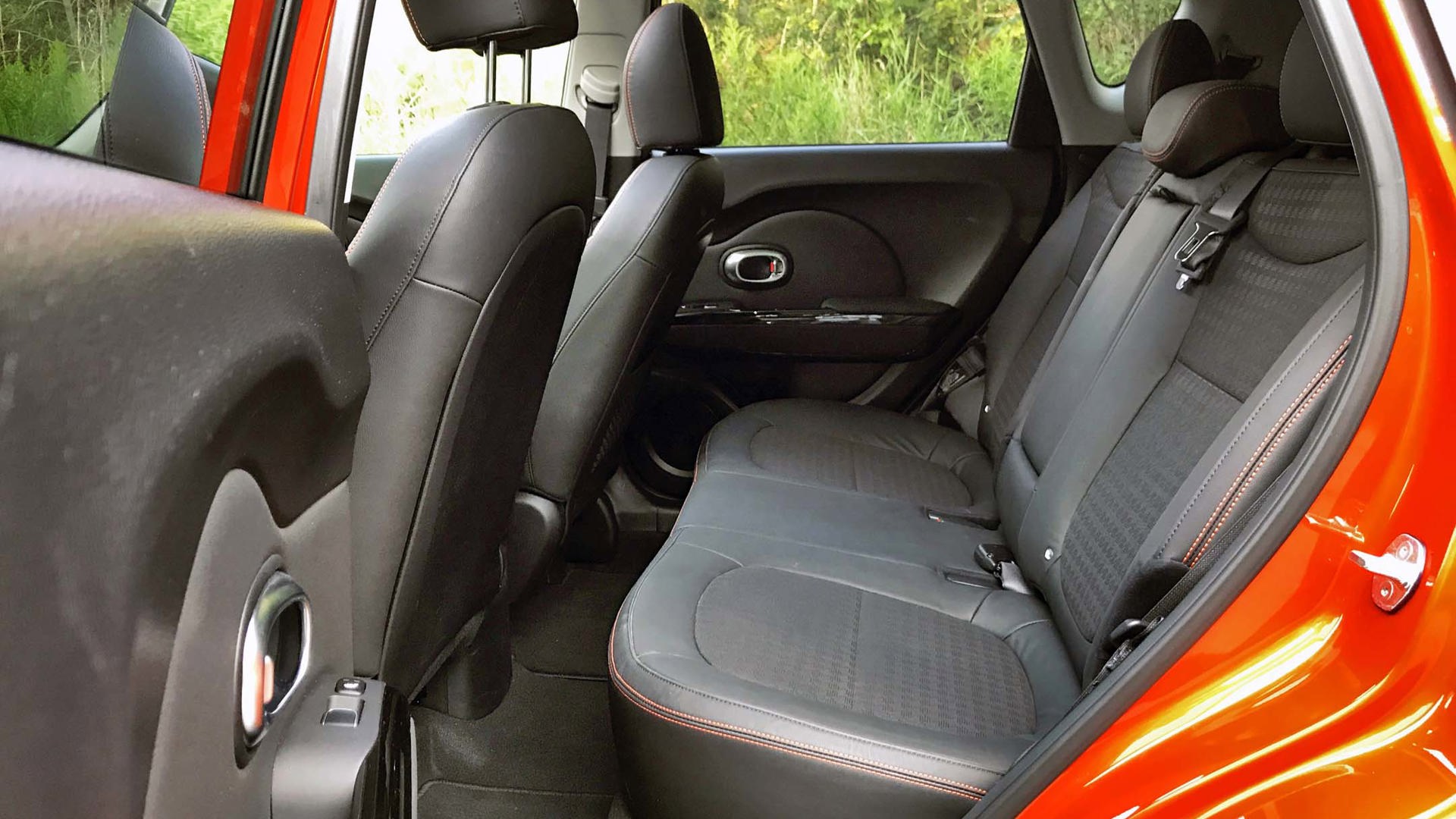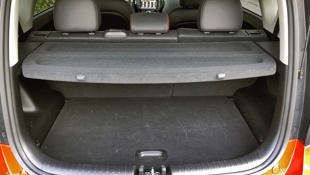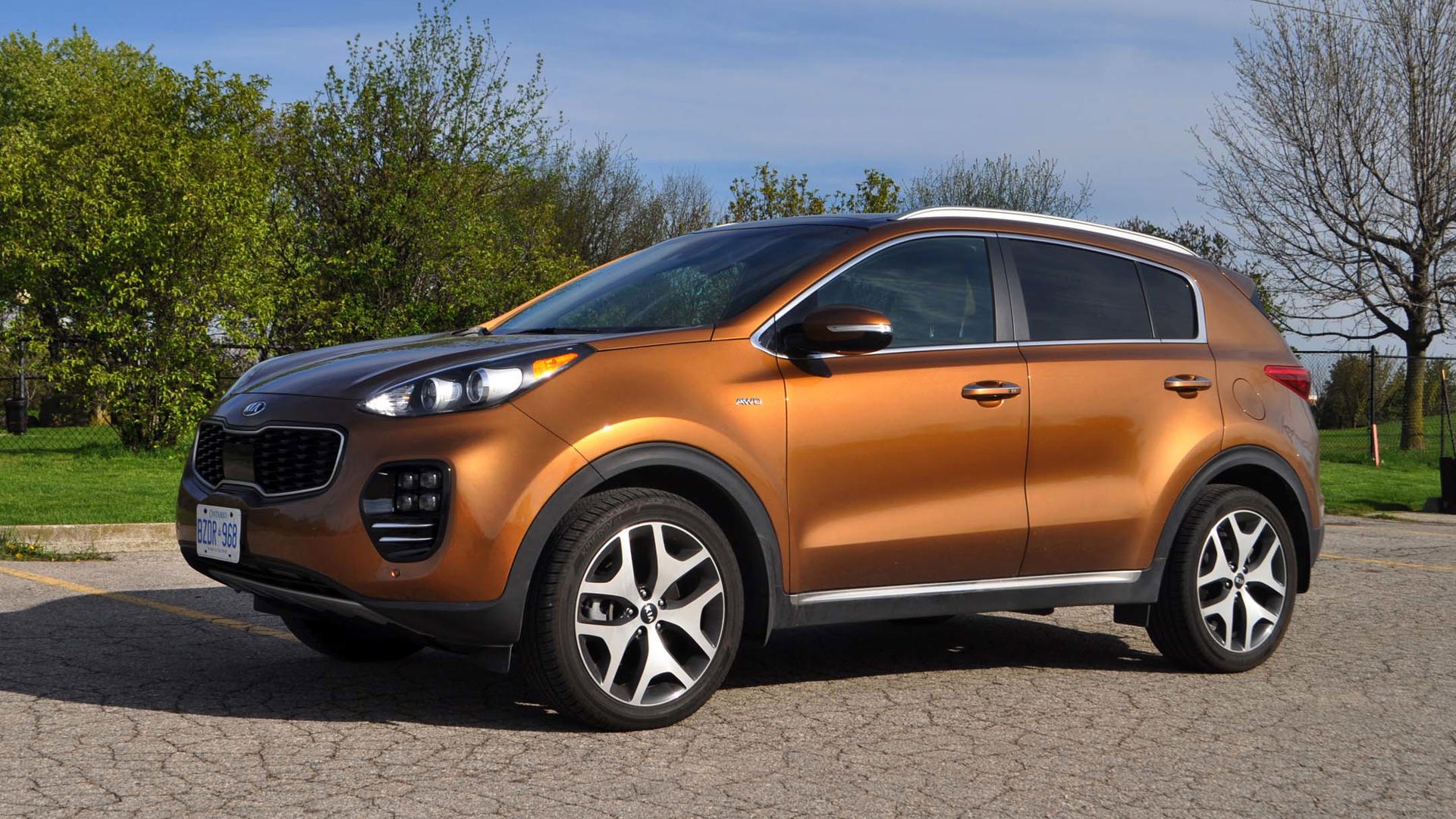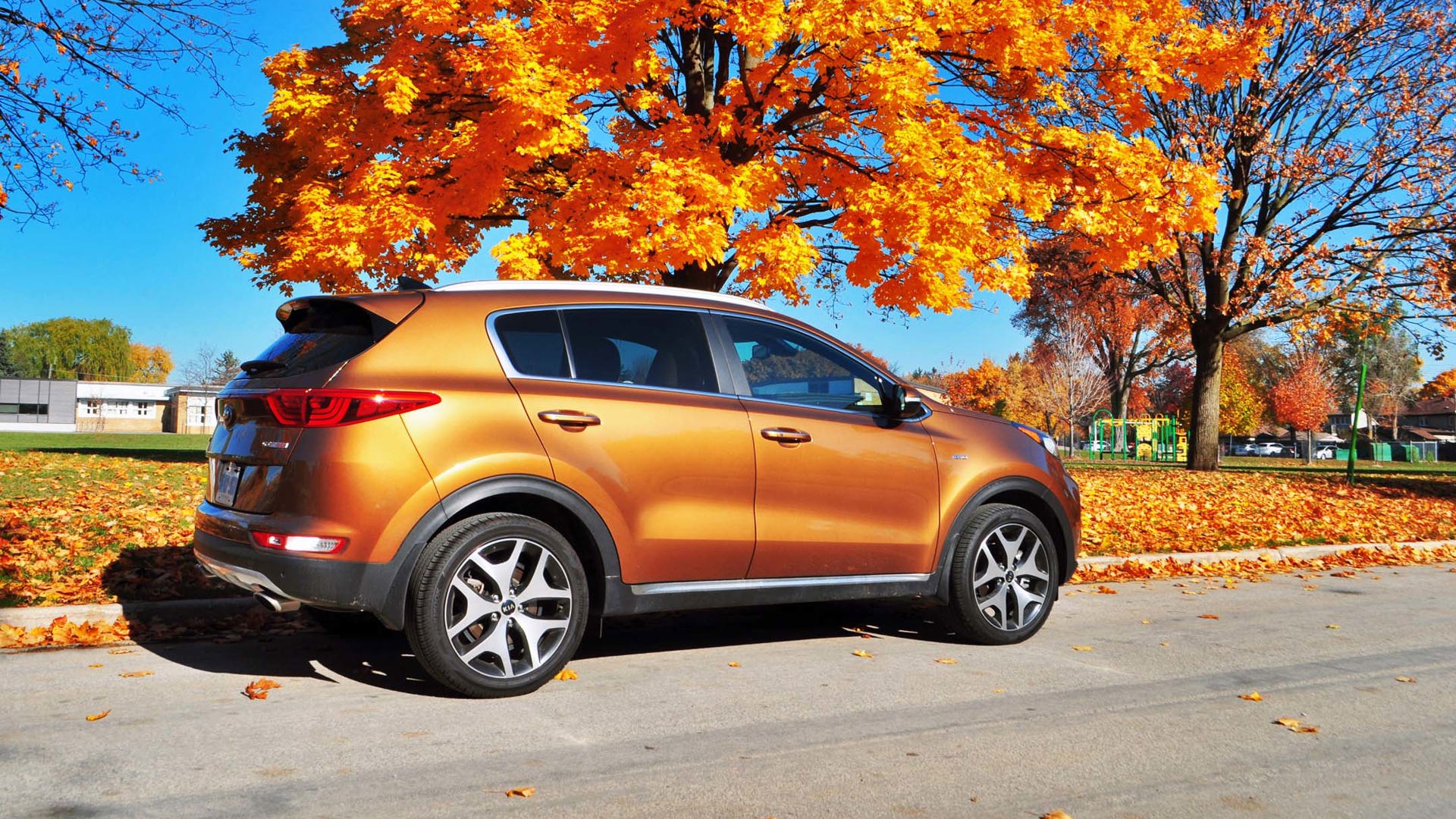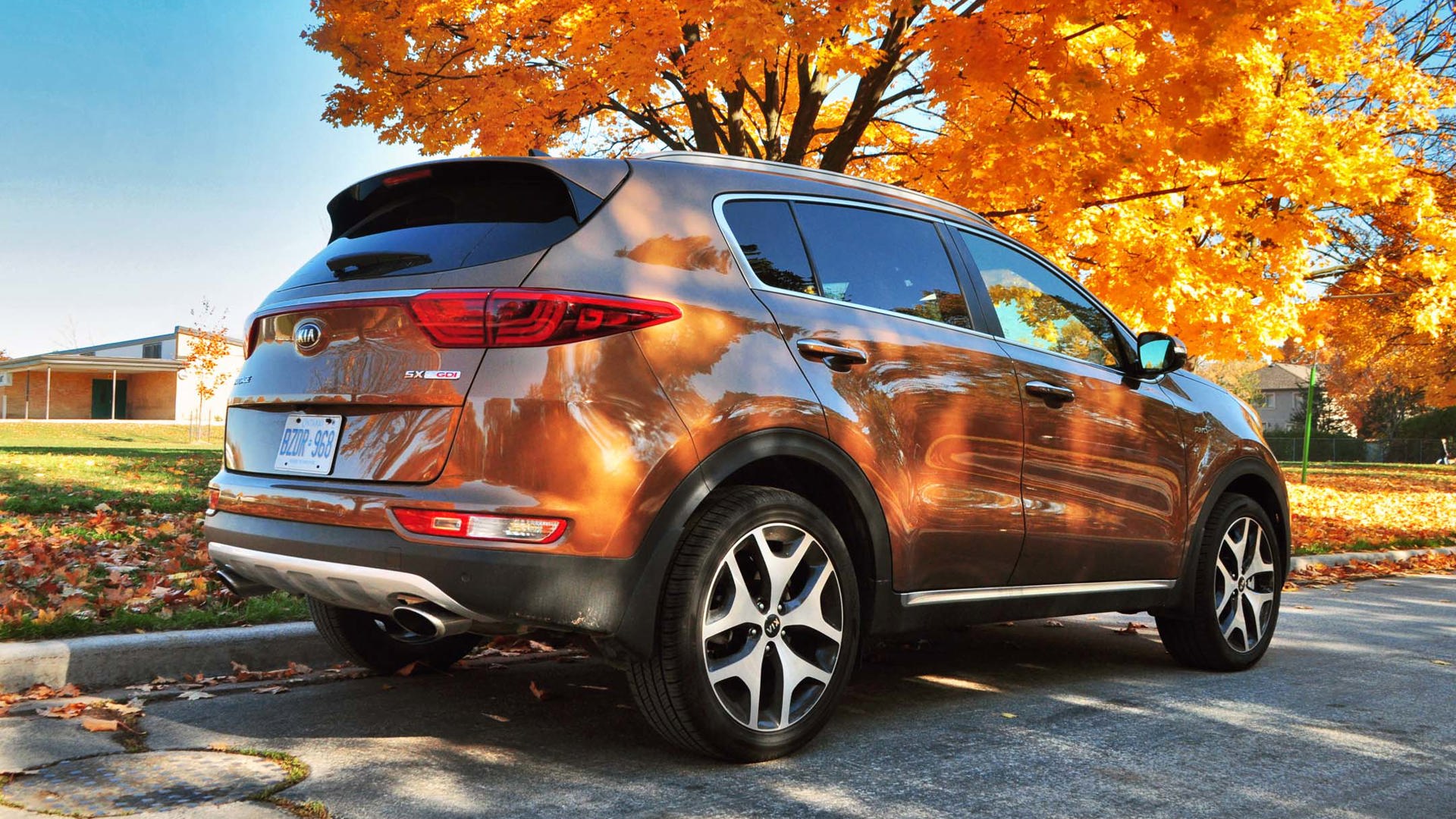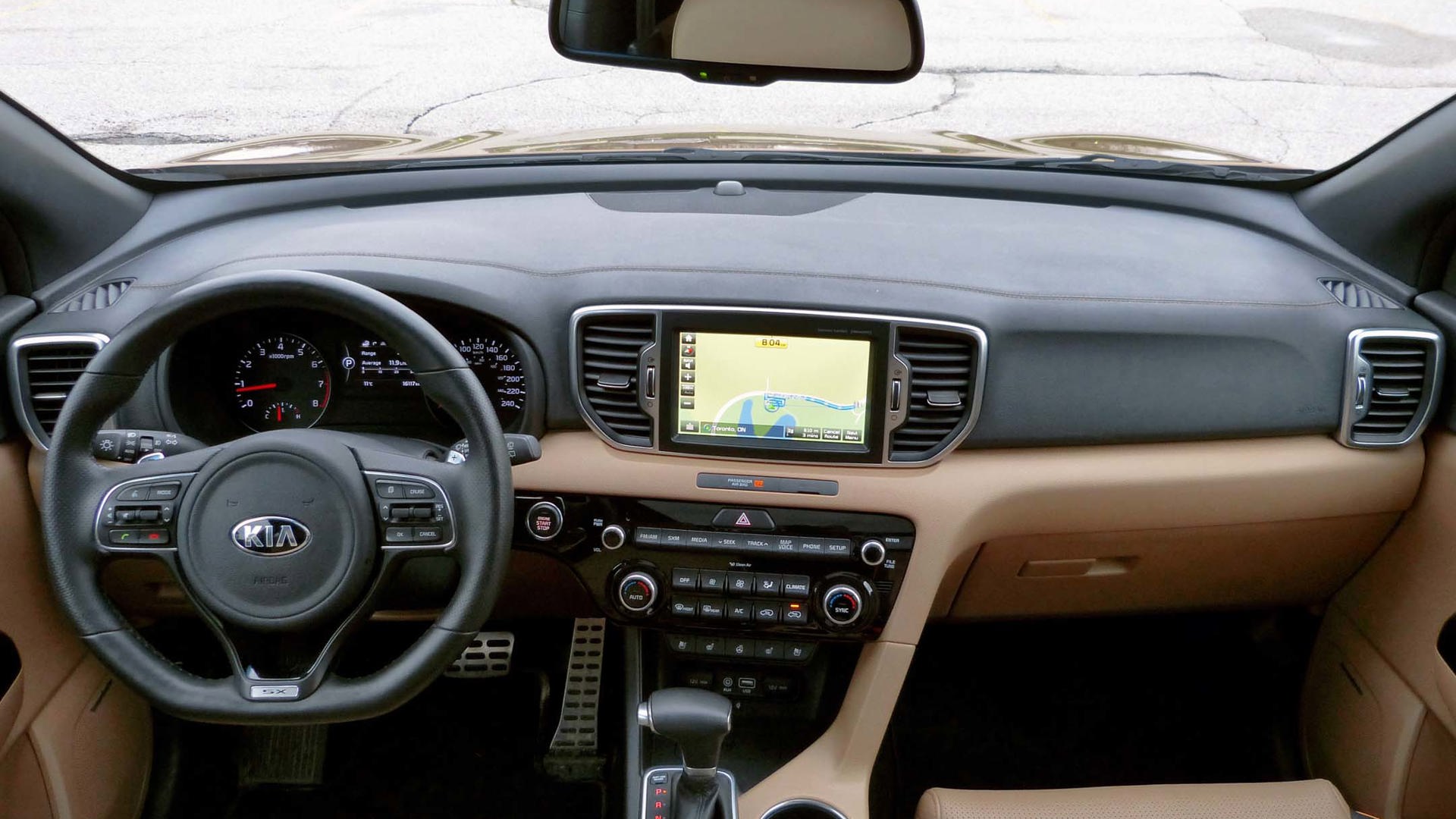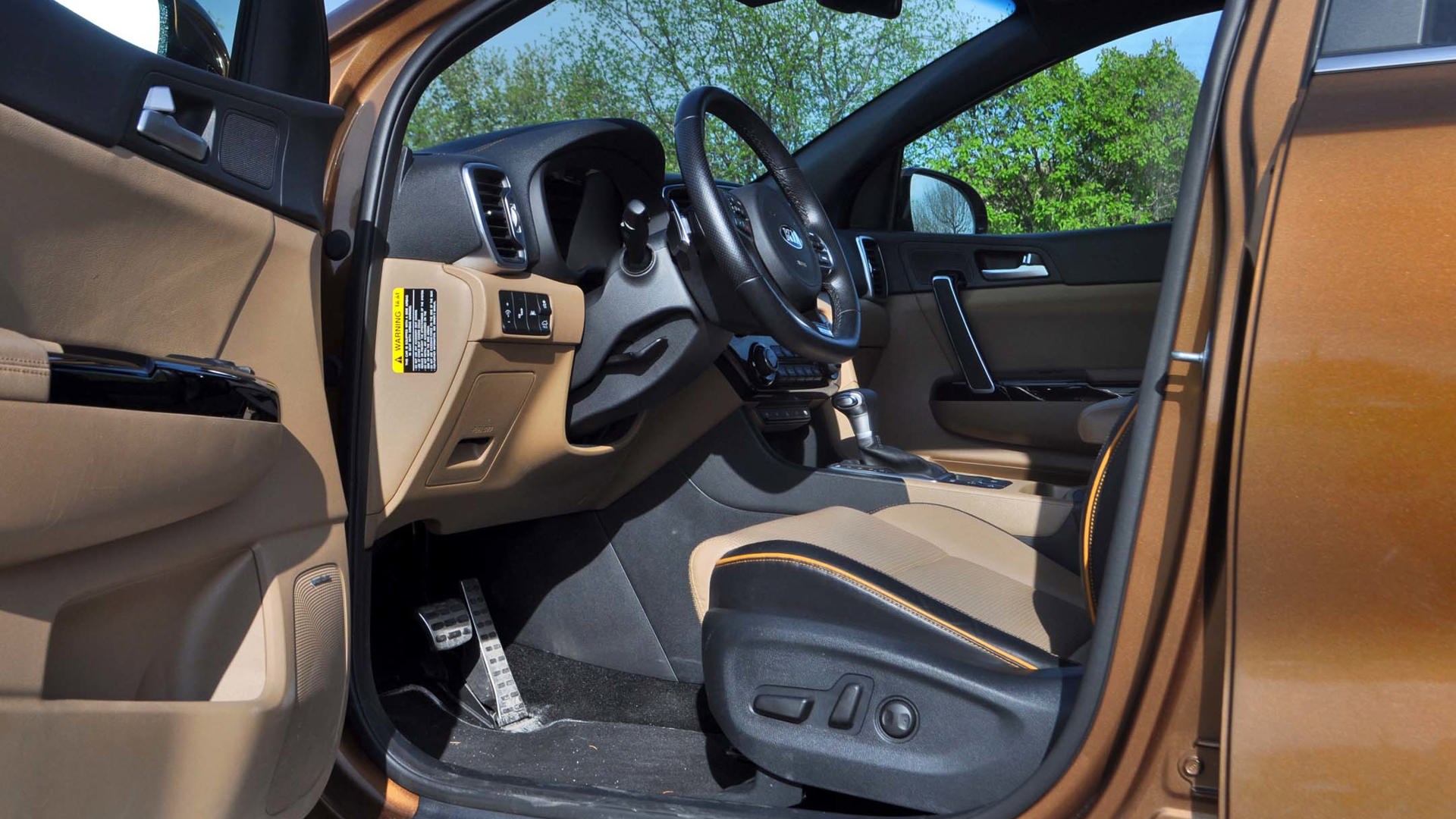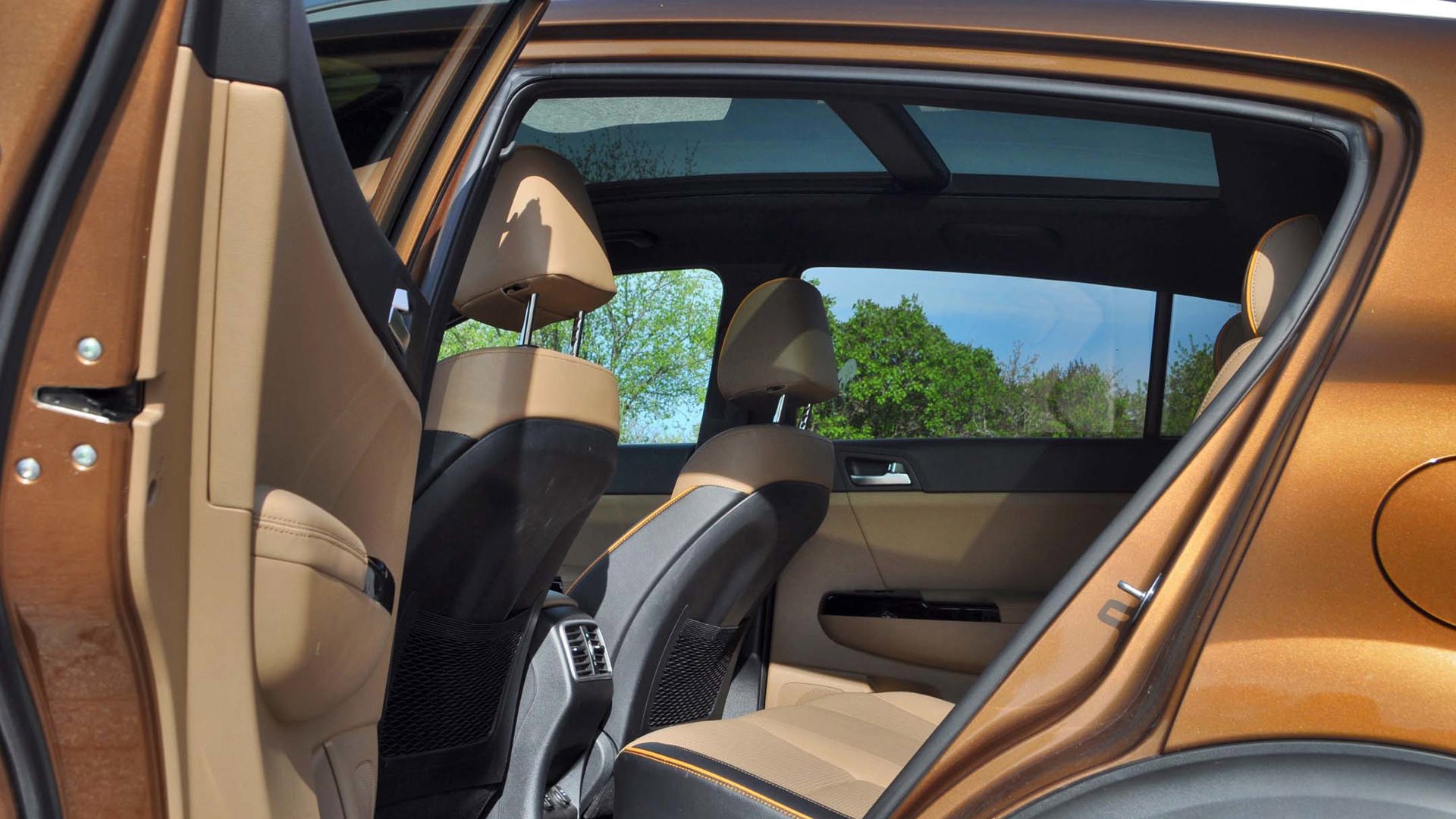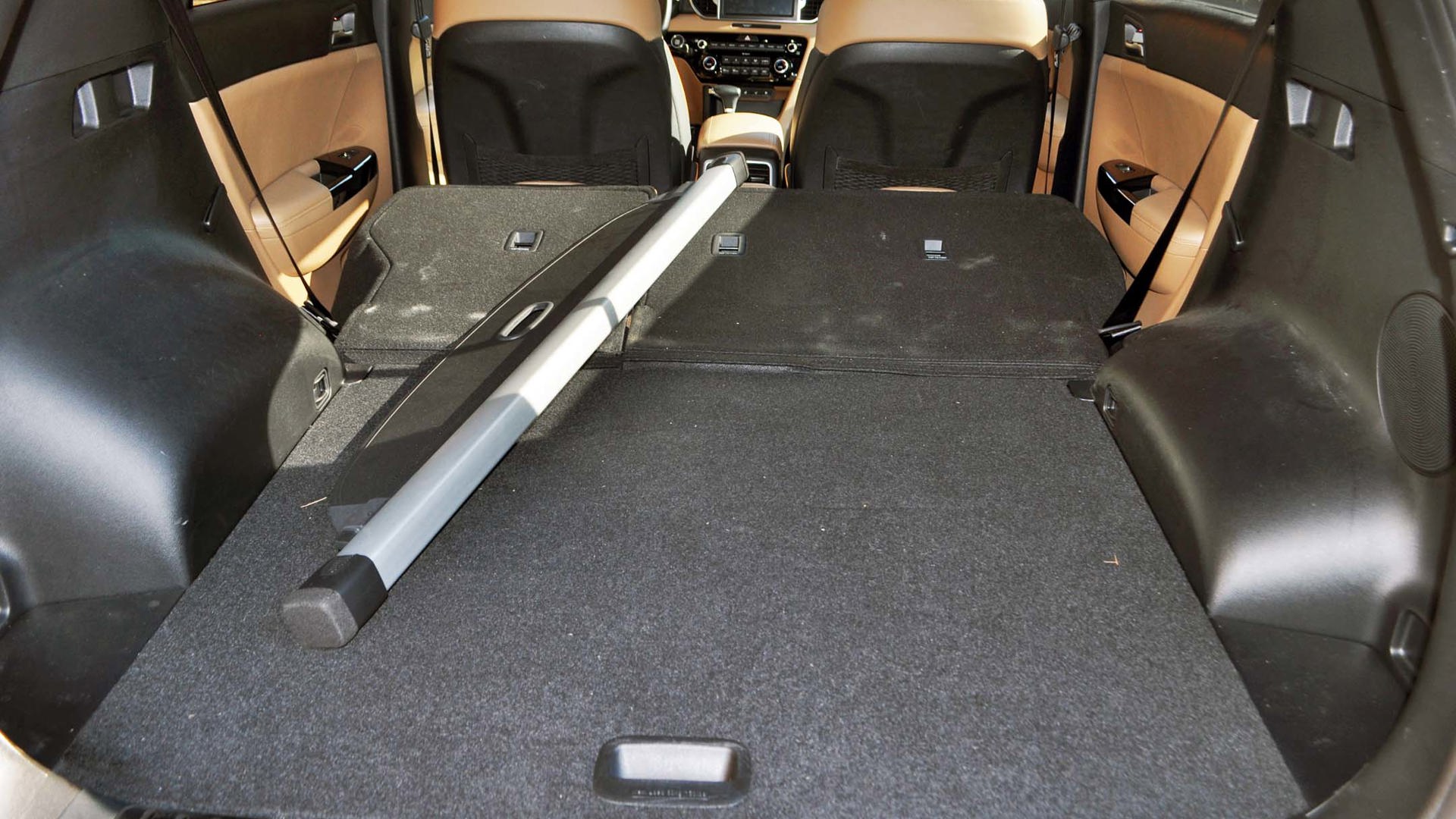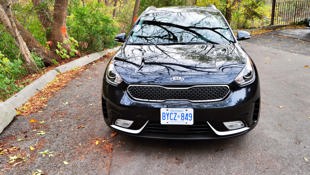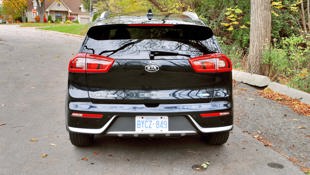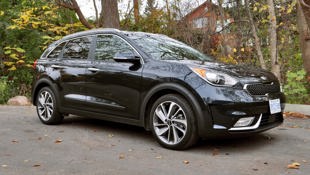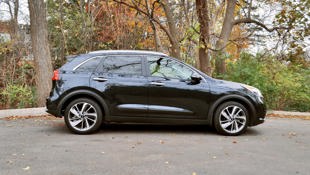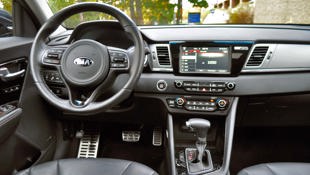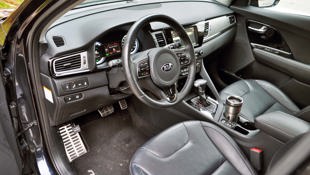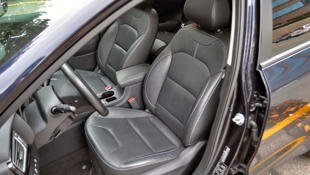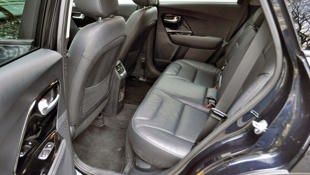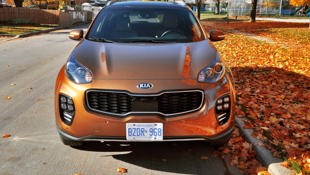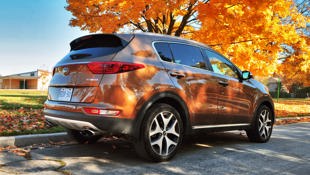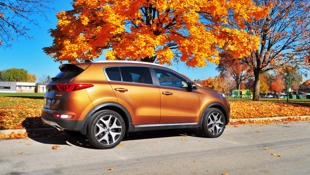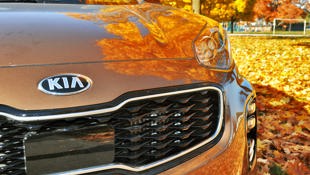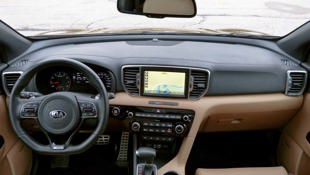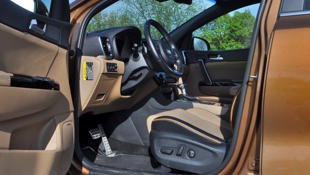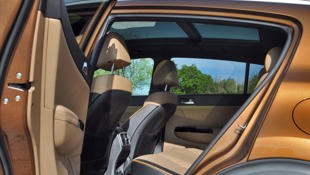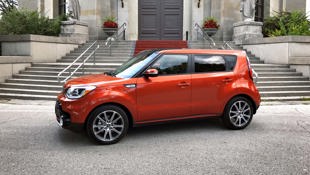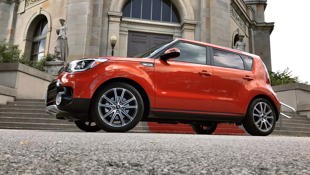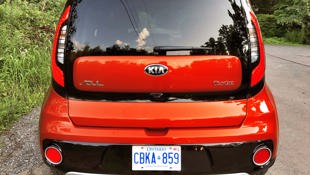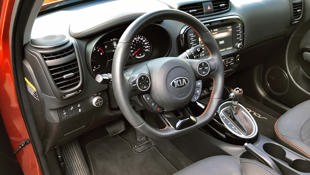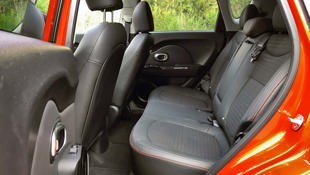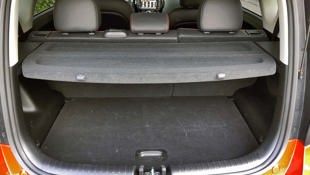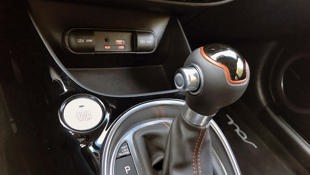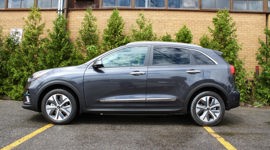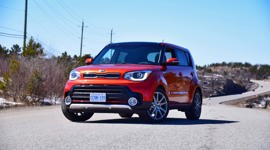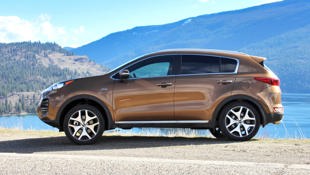Comparison Data
|
2017 Kia Niro SX Touring
|
2017 Kia Soul SX Turbo Tech
|
2017 Kia Sportage SX Turbo
|
|---|---|---|
|
Engine Displacement
1.6L Hybrid
|
1.6L
|
2.0L
|
|
Engine Cylinders
I4
|
I4
|
I4
|
|
Peak Horsepower
139 hp @ 5,700 rpm
|
201 hp @ 6,000 rpm
|
237 hp @ 6,000 rpm
|
|
Peak Torque
195 lb-ft @ 2,400 rpm
|
195 lb-ft @ 1,500–4,500 rpm
|
260 lb-ft @ 1,450–3,500 rpm
|
|
Fuel Economy
5.1/5.8/5.4 L/100 km city/hwy/cmb
|
9.1 / 7.7 / 8.5 L/100 km city/hwy/cmb
|
11.9/10.2/11.1 L/100 km city/hwy/cmb
|
|
Cargo Space
635 L/1,789 L seats down
|
532 L/1,402 L seats down
|
798 L/1,565 L seats down
|
|
Base Price
$32,995
|
$29,995
|
$39,595
|
|
A/C Tax
$100
|
$100
|
$100
|
|
Destination Fee
$1,740
|
$1,740
|
$1,740
|
|
Price as Tested
$35,035
|
$32,035
|
$41,635
|
|
Optional Equipment
$200 – Colour charge $200
|
$200 – Colour charge $200
|
$200 – Colour charge $200
|
Pulling up to the front of the Kia Training Grounds in the 2017 Kia Niro, I glanced in the rear-view mirror to see my soccer-mad 13-year-old and his similarly obsessed teammate smile at each other in giddy anticipation. This spot in the north end of the city is where Toronto FC trains, as do all its school-aged Academy players who range from 10-year-olds all the way up to 20-somethings. And we were going for a tour.
At the time, Toronto FC had surged to its and the league’s best-ever record – not only their most wins, but the most wins in the league’s 20-plus year history – and had advanced deep into the MLS playoffs. As of this writing, they’re a home win away from returning to the finals and a likely rematch with the Seattle Sounders that beat them in last year’s final game.
Kia and MLSE established the advanced facility five years ago to increase it and the team’s connection with grassroots soccer in this city and country. The Academy folks in particular work closely with Canadian national team officials to identify and develop future Olympic and World Cup talent.
So what were the boys most impressed with: the training room where all this team success was honed? The dressing room where all the jerseys of each player hung ready and waiting? Perhaps the cafeteria where young academy kids share the same specially prepared food as TFC stars? Or the single-lane lap pool, or the nearby steam room that star striker Sebastian Giovinco calls his “office” on Instagram?
Nope – their fave was the boot room, where every player’s cleats were clearly labelled and neatly hung up, spikes out, displayed proudly in all their multi-hued brightness. Except Giovinco’s, nicknamed the Atomic Ant: his boots are traditional black, always, and smaller than my son’s.
Just as the boot room’s wide variety and different styles increase its overall appeal, Kia is moving away from the traditional notion of offering one product per segment. With the release of the Niro hybrid for 2017, with other versions yet to come, Kia now offers three tall compact hatchbacks that have been variously dubbed crossovers, SUVs, and tall wagons – the Niro, the upscale Sportage and the urban boxy Soul, usually respectively.
Remarkably, all of these Kias start right around the $25,000 mark, though all three examples tested here were fully loaded right up at their $32K (Soul Turbo), $35K (Niro Touring), and $42K (Sportage SX Turbo AWD) maximum MSRPs. After a full week in each of them, the pros and cons of each compact five-seater became much clearer, beyond their varied styling.
Here then are my choices in order of what I’d recommend to friends or family in terms of overall value, though your priorities may certainly affect your own order – whether in fuel consumption or on-road performance or flashy design or even sizing.
Third Place: 2018 Kia Niro SX Touring
Hybrid slickster
If choosing strictly on looks, this would be my number one. Sharing a platform with Hyundai’s Ioniq compact hatchback, the taller and more debonair-looking Kia Niro Touring is a $35,035 (as tested) mini-crossover, with an advanced but somewhat raucous gas-electric powertrain offering up by far the best fuel economy of its Kia brethren.
Officially, the Niro Touring clocks in at a miserly 5.4 L/100 km in combined city and highway driving, which is literally half of the official consumption numbers of the larger and much more powerful Sportage in its top turbocharged and all-wheel drive trim (11.1 L/100 km). In real-world driving, the Niro’s instrument cluster reported sadly thirstier numbers, varying widely but generally around 7.9 L/100 km, even when the dash reported I averaged 65 percent Economical driving, 35 percent Normal, with no driving rated as Aggressive.
So the Niro will snitch on your driving habits better than it will deliver Prius-like fuel efficiency savings, going by my time with it. Looked at objectively, either figure is still a very low number for any CUV/SUV, though the lack of all-wheel drive – even as an option – will disappoint some potential buyers, and scratch it off their list.
On the plus side, the Niro offers a host of luxury level features for a very reasonable price, with a heated steering wheel, heated and cooled leather seats for both front passengers, as well as heated seats for rear passengers all included in the Touring package. Advanced safety systems are part of the Niro’s slick appeal, with autonomous emergency braking, blind-spot detection system and a lane-departure warning system all included in this top package.
The driving performance and comfort side is where the Niro falls behind in this group. You’d think that a hybrid – that offers whisper-quiet all-electric trundling through drive-throughs and nudging along in traffic – would ace the refinement test. But when the 130 hp gas-hybrid engine comes on, it really comes on, with more noise than forward thrust. Combine that with a ride that seemed controlled but slightly bouncy, and the economy-minded roots of the platform peek through.
Kia did an excellent job hiding the powertrain components, so the cargo area is nice and flat and roomy. There’s no unwieldy battery hump as in other hybrids, and there are even storage compartments under the cargo floor. So no issues there.
But the overall quality of the amenities sometimes left a bit to be desired: the heated steering wheel button occasionally became fussy and sticky on our tester, staying down a couple times when not engaged. The leather was not the most fragrant or convincing. The infotainment system offers Android Auto and Apple CarPlay, but didn’t always play nicely with CarPlay, or at least the Apple iOS 11.0, which was new at the time. Regular Bluetooth audio is also available and worked fine.
In the end, with no all-wheel drive or plug-in capability (yet), this top-line Niro feels like a $25,000 tall hatchback with an advanced, frugal yet loud $10,000 drivetrain – which basically, it is.
Second Place: 2017 Kia Sportage SX Turbo
Fleet-footed outdoorsy sophisticate
The largest, most powerful, and most luxurious of this group is the Sportage Turbo – and it’s also the only one here to offer all-wheel drive. Of course, one pays to play for all this pace and sophistication: its as-tested price of $41,635 is the highest of this Kia threesome, and pushes the upper edges of this category as well.
This is therefore the athletic, outdoorsy yet mannerly team captain of this group, with the widest and most refined abilities. It also stacks up well outside the Kia family, finishing just off the podium against nine other all-wheel drive compact SUVs in our big $40K cute-ute comparison earlier this year.
The driving feel of the Sportage Turbo is more hot-hatch than SUV, with its powerful 237 hp engine even seeming underrated, especially when you note the 2.0-litre turbo four’s 260 lb-ft of torque. And that low-end oomph is available at a mere 1,450 rpm, right above idle where the lack of turbo lag and smooth operation does an impressive impression of a larger and thirstier V6.
It’s true that it doesn’t handle quite as well as the best hot hatches, but in this segment, its handling is top-class, its sporty driving feel reinforced by the D-shaped steering wheel and shift paddles for the six-speed automatic. There’s also a fine balance between body roll control in corners, and everyday comfort, its sporting touches adding a playful bit of fun to its luxury-oriented personality.
It also feels a level above in terms of size and sophistication than the Niro and Soul Turbo, which it is, and much closer to its larger Sorento SUV big brother. Which it also is, in engineering and price.
You’ll find many luxuries not common (or entirely unavailable) elsewhere in the segment: heated steering wheel, leather seats (here with accent colour piping) both heated and cooled for both occupants up front, while rear passengers will be delighted to see heated seats back there on frosty cold days.
But there are also additional niceties not found on the others, as well as more space and comfort in general. There’s a power switch on the tailgate, or you can simply wave your foot under it to close it when your hands are full. There’s a huge panoramic sunroof which helps brighten up the interior for rear passengers as well.
The advanced safety systems here include autonomous emergency braking, blind-spot warning, and a lane departure warning system. There’s also a rear cross-traffic alert system that’s useful when backing out between two monster SUVs at the mall. Which seems constantly lately.
Where the Sportage Turbo falls down is in its fuel efficiency. Officially, it averages 11.1 L/100 km, and closer to an even 12 as measured at the pump. This is the downside of all that power, and the Sportage’s relatively heavy curb weight. But unlike some high-performance turbo fours, it happily accepts regular fuel, which helps mitigate those fuel costs.
Overall then, while there is much to appreciate about the Sportage Turbo, as it literally does almost every single thing well, its higher price means the overall value equation is just slightly better with something else.
First Place: 2017 Kia Soul SX Turbo Tech
Party machine plus boost equals fun squared
Take one boxy subcompact runabout known for its funky styling, rave-ready interior, and then add turbo boost to the dynamic mix, and you have a formula for fun in the form of the Soul Turbo, introduced as a 2017 model. But the Soul Turbo offers many of the luxurious niceties that so impress in these other Kias at a price that’s roughly $10K below the Sportage, and is less expensive while considerably more fun to drive than the Niro.
Sadly, this Soul Turbo’s powerplant is not the mighty 2.0-litre turbo four that’s in the Sportage. But the 201 hp that’s available from the 1.6-litre turbo four is a worthy upgrade from the meek 130 hp in the base $20K Soul, granting it a 0–100 km/h time of roughly 7.5 seconds. Its boxy shape even allows its relatively small body to provide a hefty amount of cargo room, at 532 L, or 1,401 L with the rear seats folded, though still smaller than the Niro and Sportage.
Sure, there’s no hiding the relatively unsophisticated suspension – it’s not a rough ride, but do you feel some tininess on bumps where some rattles can sneak through, and attacking corners is clearly not this car’s, um, forté. But it is what it is: a well-sorted economy car-derived suspension. And many folks are fine with that. The lack of all-wheel drive doesn’t seem as surprising here as in the Niro either, perhaps because of its less SUV-ish body.
Where the real fun factor comes in is in the interior. Fun accent lights surrounding the bottom door speakers glow multi-colour LED hues, either on a rotating basis or set to the beat of the music. It’s strangely amusing to set it like this while listening to talk radio. But the lights and the extra power and eight-speaker sound system all combine to forget the talk radio, turn up the tunes, and get going now.
Speaking of which, the fact that the Soul Turbo starts at $26K is an impressive upgrade from its base version in terms of punch as well as features for the dollar. Move up to the top Tech package of the Soul Turbo as equipped here, and it includes those wonderfully heated features – seats front and rear, plus steering wheel – along with easy-to-clean leather, the fun flat-bottomed steering wheel, and ventilated seats that you’ll be happy to have after parking your car in the sun on a hot summer’s day.
Perhaps most impressive, the fully loaded Soul Turbo also offers the same impressive list of daily and advanced safety features as the other two: blind-spot detection, lane-departure warning, rear cross-traffic alert, and autonomous emergency braking. And all for an as tested price of $32,035.
At the end of the day, Kias are tough to beat value wise in general, with their generous piling on of high-end features. But when all three of these siblings come to the party with similarly loaded party platters, the smallest and least expensive is not only the best value, but the most fun to boot.
